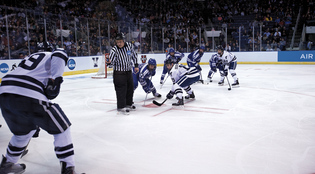 loading
loading
featuresIce ageThough they were again stopped short of the “Frozen Four,” the men’s hockey team was ranked number one in the nation for eight weeks this winter. The Bulldogs have become a national power. Michael Obernauer ’02, a sportswriter in New York, labors as a defenseman on the weekends.  Bob HandelmanYale faced off against Air Force in the first round of the NCAA East Regional Tournament, their third straight trip to the NCAA postseason. Yale and Fairfield University cohosted the regional tournament at Bridgeport's Arena at Harbor Yard. View full imageWhen it was over, when the most prolific and captivating hockey season Yale has ever seen reached its all-too-early end, it was the sounds that stood out. There was Jimmy Martin ’11 click-clacking his way up the wooden dais of the interview room, because the captain couldn’t bring himself to take off his uniform, not even his skates—not yet. There was Broc Little ’11, eyes red, speaking softly and deliberately as he tried, not entirely successfully, to keep his voice from trembling. And there was the muffled sound, every time the door swung open, of Minnesota–Duluth’s celebration in a nearby dressing room. As the saying goes, the higher they climb, the harder they fall. Now was not a time when the graduating seniors—who were about to peel off their Yale sweaters and leave them behind for good—could contemplate, and marvel at, the significance of this scene. The three players who trudged in for their obligatory interviews after losing the NCAA East Regional Final for the second straight year—falling just one win short of the “Frozen Four,” college hockey’s national semifinals—were three of the principal reasons the Yale men’s hockey program had risen to such lofty heights in the first place. Just happy to be here? Not these guys, not anymore. “There is no question about it: Yale has arrived at an elite level of hockey,” says Bob Brooke ’83, who starred at Yale before moving on to a seven-year career with the New York Rangers, Minnesota North Stars, and New Jersey Devils of the NHL. “That’s not taking away from the special group that this might be. It’s just great for Keith Allain, great for those players, great for Yale. That program has arrived.” You could argue that it was a long time coming. It was a group of Yale students who brought ice hockey from Canada to American colleges back in Grover Cleveland’s second term, and who played the first intercollegiate game, against Johns Hopkins in February 1896. The problem is, Yale’s national success in hockey—or football, or basketball, or baseball, or any of the sports that Americans fill arenas to watch—has long been thought to be a thing of the past, visible only in old black-and-white photos at Mory’s. So you could forgive students and alumni if they were surprised to see the banner headline of the Yale Daily News on December 8, 2010, over a picture of the hockey team: “YALE IS NO. 1.” It was an unprecedented feat for the program, and no fluke or flash in the pan, either: a December weekend sweep of Rensselaer and Union, part of a ten-game, two-month-long winning streak, pushed the Bulldogs to the top of both major national polls, where they would stay for eight weeks. Making up in speed, skill, and relentlessness what they lacked in size, the Bulldogs would finish the season tops in the nation in both offense (4.19 goals per game) and defense (2.06 goals against per game). By January 22, their record stood at 17–2. By March, they had swept their way to a second ECAC tournament title in three years. (Yale and the five other hockey-playing Ivy schools compete in the ECAC, a conference that also includes six other Northeastern schools.) Their record stood at 27–6–1, and—much to the chagrin of the more traditional NCAA hockey powers, who sometimes deride the Bulldogs’ conference as the “EZAC”—Yale entered the NCAA tournament as the number-one overall seed. Brooke, who now lives in Minnesota, made several trips back East to watch his old college team play, including a memorable one on a January evening at the customarily sold-out Ingalls Rink. By the time he walked through the front doors, the Whale was already jammed and the Yale Precision Marching Band was blaring. “It gave me chills,” he says. “I thought, ‘I’m walking into the home of the number-one team in the nation.’”
|
|